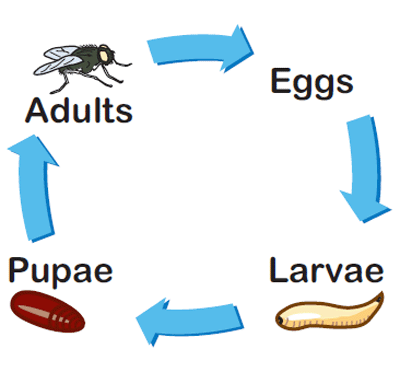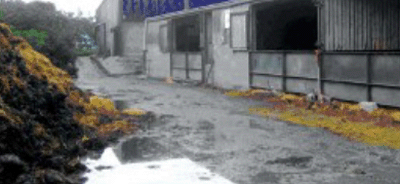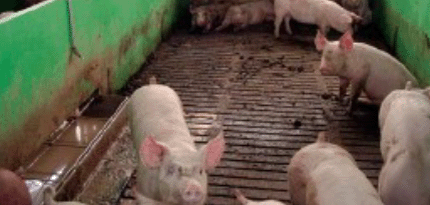



Insect Control on Pig Farms
Effective control is an integral part of maintaining high health and productivity in modern pig production. No. 36 in the 'Action for Productivity' series from BPEX explains how to develop a control programme.The control of flies, cockroaches and other insects is important because they can transmit disease among pig populations. Fly populations can also cause a nuisance to pigs and become a welfare concern, as well as generating complaints from neighbours. Effective control is an integral part of maintaining high health and productivity in modern pig production. Having a control system in operation also forms part of assurance standards.
Targets
- Monitor the fly population throughout the year; do not wait until fly numbers are at unacceptable levels before trying to reduce them
- Identify sites where insects are breeding on your unit and remove material weekly
- Have a written integrated pest management plan which specifically addresses flies and cockroaches as primary pests
Many types of fly can occur on pig farms, but the dominant and most noticeable ones are filth flies, with the most common species being the housefly Musca domestica. Some producers can consider them a “normal” and unavoidable consequence of pig production. However, there are many negative impacts of large insect populations on animal health and welfare, which makes the effort to control them well worthwhile.
- Flies can carry a huge range of pig pathogens, including E. coli, Salmonella, Brachyspira (swine dysentery), Lawsonia (ileitis) and tuberculosis
- Cockroaches can transmit B. hyodysenteriae and PCV2
- Adult flies usually live for between one and two weeks, during which time they can spread pathogens around the farm, for example, new batches of pigs and clean pens and feed bins
- The natural tendency of insects to wander and their ability to fly distances of several miles, gives them the potential to spread disease between farms.
Life Cycle of the Fly
The housefly can complete its life cycle in as little as seven days, so given the right conditions very high populations can develop rapidly. Animal housing can provide very attractive conditions for flies, as well as other insects, with plentiful food, breeding sites and warm temperatures all year round in heated farrowing and nursery buildings.
Life Cycle of a Fly

The speed at which flies can complete their lifecycle depends on the temperature. As manure and rotting material is much warmer than the ambient temperature, they can develop much faster than might be anticipated.
Management Guidelines
Integrated fly control and manure management
The periodic use of chemical control when numbers of flies become intolerable may produce a temporary drop in the number of adult flies. However, as adults make up only 15 per cent of the total fly population they will soon be replaced.
To keep fly numbers at an acceptable level throughout the year, an integrated fly control programme is essential:
- minimise the breeding sites available to flies with an effective manure management strategy
- wet and dirty straw and other bedding material is a perfect fly breeding habitat so remove at least twice each week to break the seven-day breeding cycle
- pay attention to areas where dirty material may collect, such as the corners and edges of pens and under feeders
- larvae are unable to survive in very liquid manure/slurry, however, debris and floating mats will allow flies to breed in slurry stores
- carcass disposal sites must be covered to prevent fly access
- accumulations of spilled feed create ideal breeding sites.
What type of insect control works best
A programme aimed at reducing infection levels or posteradication re-infection should include appropriate biosecurity and pig medication/vaccination, as well as insect control measures, targeted at cockroaches and flies.
Chemical Control
Adulticides
- These can be used as baits, sprays, paints and mists
- They can rapidly reduce high numbers of adult flies
- They will help to stop flies from laying more eggs and spreading bacteria and other pathogens around the farm.

Larvicides
- These will prevent larvae from developing into adult flies
- As eggs and larvae make up a large percentage of the fly population larvicides applied to breeding sites can significantly reduce the number of new adult flies emerging.
Non-chemical control
- Screens: these can be used alone or, more effectively, in conjunction with insecticides
- Good ventilation: Insufficient airflow results in condensation forming in houses. Within the constraints of animals needs, as much airflow as possible should be maintained to promote moisture removal from manure and other fly breeding media
- Clean up spilled feed regularly, eg from under troughs, augers and feed bins
- Keep vegetation surrounding pig buildings and yards under control and clear any spilled manure or feed from these areas
- All-in all-out management means that empty buildings can be thoroughly cleaned and disinfected eliminating the majority of insects and their breeding sites
- Reduce the movement of equipment between buildings to reduce the risk of re-infestations.

Resistance
Intensive use of the same insecticide can result in resistant flies in as little as two years. To slow the development of resistance it is advisable to rotate the chemicals used on the unit, choosing products which are based on different active ingredients.
Further Reading
Find out more information on the diseases mentioned in this article by clicking here.
June 2013








